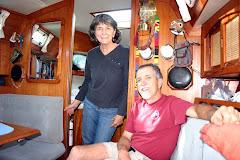
After a month of impromptu (yet tasty) lunches on Evergreen, mostly eaten on our laps, we now sat down to a 3-course formal meal accompanied by wine, and surrounded by guests of at least 4 other nationalities. After lunch, we investigated our new surroundings. Although it's a small ship (350 feet or so), the Aranui is equipped with a pool, fitness center, library, shop, and several bars. At every turn, we were greeted by super friendly, helpful (and very attractive) Polynesian crew members. I kept expecting to wake up from this pleasant hallucination!
After watching the ship depart from the small harbor at Hiva Oa, we were heading back down to our cabin for a snooze when we heard the sound of many voices singing. We followed the joyful noise to a lounge area where our new buddy Manaariii, who turned out to be the activities director, was leading a group of about 30 in Tahitian dancing and singing. We tried to follow along, but we had already missed the first 5 lessons, and decided that it was probably going to take too much work to catch up.
Few people visit the Marquesas – the current estimate is about 3500 a year. Fewer still make it to Fatu Hiva, the most remote of the populated islands in the archipelago. So we must be among a very few who have actually been there twice! Yes, this was to be our first destination after boarding the Aranui in Hiva Oa. I was a bit sorry that we were spending so much money to see something we had already seen. I needn’t have worried.
Although it does carry up to 140 tourists, the Aranui is a true freighter, carrying goods of all kinds from Tahiti to the Marquesas, and returning with the copra, noni, and fresh fruit produced in these remote islands. At any given stop, you might see the cranes loading or unloading outrigger canoes, cars, cows, or Coke. The arrival of the Aranui, approximately every 3 weeks, is a big deal, and everyone turns out to greet her.

We were ferried to the Omoa wharf in outboard-powered barges. Once ashore, we saw a couple of things we had missed during our first visit here. We were taken to a palm-thatched shelter to see a demonstration of island crafts. First we were shown how tapa cloth is made, from the bark of several local tree species.

Next we were shown the art of arranging flowers, leaves and roots into fragrant bundles that are tied into women’s hair for special occasions. Everything used in the arrangement was first passed around, and the aromas were just incredible! These lovely scents are some of our strongest memories of Polynesia.

We were ferried back to the Aranui for lunch, and while we were eating the ship moved 3 miles along the coast to Hanavave. We had met only a few of the inhabitants here last week. This time, as we came ashore, most of the village was there, in traditional garb, dancing and serenading us with ukeleles, drums, and song.
Back on the boat, we attended a very interesting lecture on both the history of the indigenous people of the Marquesas, and a recap of the mostly sad events since European contact. After this first full day aboard, we could see that a significant benefit of visiting the islands as an Aranui passenger would be seeing, and learning about, much more of the local culture!


No comments:
Post a Comment